Lifestyle
Can Regular Sauna Use Make You Happier and Live Longer?
For most people who regularly use the sauna after a workout, you don’t need to tell them it’s healthy, they can feel it! Even though it can be uncomfortable in the sauna itself, it leaves you feeling great afterwards, as long as you remember to rehydrate!
However, it’s not just a feeling, there is actually a lot of science behind why a sauna is great for physical and mental health. In this article, we’re going to go over them in detail. This should hopefully give sauna fans extra motivation to keep getting a sweat on as often as possible. And perhaps, we may even get some of those who aren’t regular sauna goers to give it a go.
TL;DR: Yes, regular sauna use can indeed make you happier and help you live longer! The optimal duration is at least 19 minutes per session, and 4-7 sessions per week.
Table of Contents
Sauna before or after workout – which is better?
There are no rules that say you can’t use the sauna before working out. But if you’ve ever used one, then it really shouldn’t come as a surprise why using it after strenuous activity is preferable.
Saunas can be incredibly relaxing, so much so that the last thing you want to do when you finish is to exercise… Taking a quick nap, watching TV, or going for a leisurely stroll are more likely activities if it’s too early for bedtime. But, of course, it’s all just a matter of personal preference. So far, the studies done have been on the effects of using the sauna. No concrete evidence points to whether it’s best to use it before or after a workout (1).
5 Sauna benefits after workout (with science-backed evidence)
Saunas aren’t just a fad – they’ve been in use for thousands of years! And there’s good reason why they’re still around today. Here’s what the science says about using saunas:
1) Sauna Discomfort is Healing
Perhaps you’re familiar with the term endorphin? It’s the feel-good chemical that our bodies release after a workout. It creates the feel-good post-workout feeling of calm and relaxation by acting on the opioid receptors in the body.
However, during the workout itself, another chemical is produced. This chemical is effectively the opposite of endorphin, and is known as dynorphin. Dynorphin creates feelings of discomfort when we exercise.
Heat stress also stimulates dynorphin release. As you know, saunas are literally heat machines, so they can definitely trigger dynorphin release!
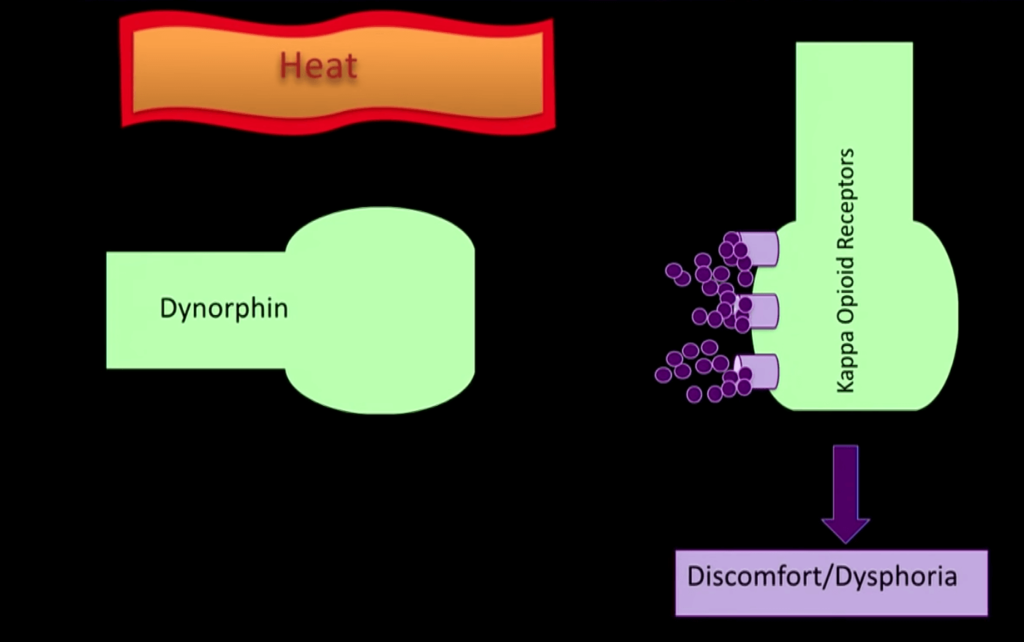
Dynorphin as shown in the image above stimulates the Kappa opioid receptors, which produce feelings of discomfort or dysphoria. Basically, they create an urge to get out of the sauna.
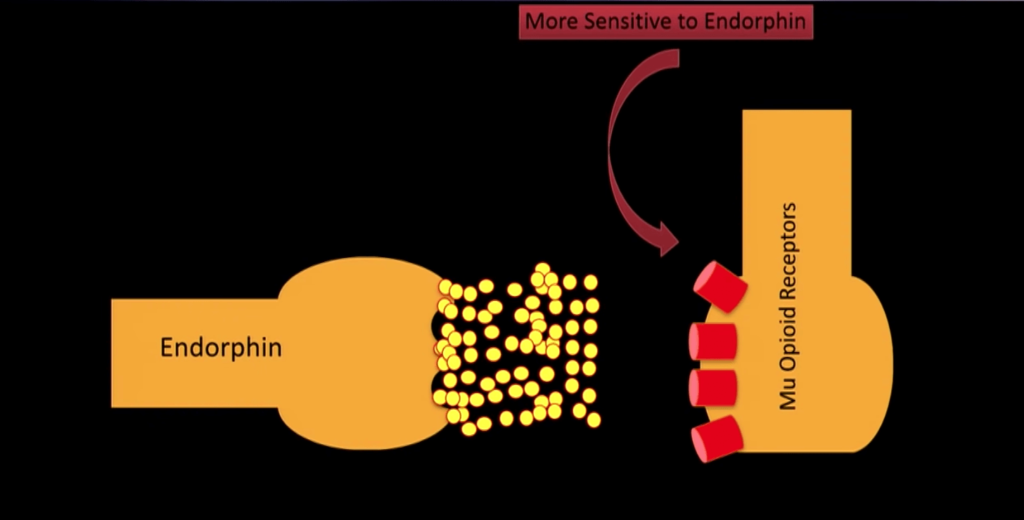
However, dynorphin is actually a good or beneficial stressor, a.k.a. a “eustress“. The stress forces the body to adapt physiologically, thereby improving health.
In the case of dynorphin, it actually leads to the production of more opioid receptors that endorphins can bind to. These receptors are known as Mu opioid receptors. Both new and existing Mu opioid receptors become more sensitive to circulating endorphins.
Sauna discomfort boosts mental and physical health
With regular sauna use, people develop the ability to get greater positive effects from endorphins. Endorphins help to reduce pain, stress, anxiety and depression. These are some of the reasons why saunas are great for mental health.
Research has also suggested that saunas may help to increase serotonin levels in the brain. Serotonin is the feel-good neurotransmitter that most anti-depressant treatments try to increase (2).
Regular sauna use has also been found to reduce the pain associated with osteoarthritis, rheumatoid arthritis, and fibromyalgia (3, 4). Moreover, it’s also been found to reduce the symptoms associated with mild depression (5).
2) Heat Shock Proteins
Sauna also significantly upregulates the production of heat shock proteins. These proteins work a little like bodyguards. They protect other proteins from stress which can change their structure. Heat shock proteins also ensure that proteins maintain their correct structure as they are made.
Heat shock proteins were originally discovered in studies where cells were exposed to heat as a stressor. But it’s now known they’re also produced in response to other stressors such as cold and injury. But heat remains a very strong stimulator in their production.
Proteins can be extremely complicated molecules. During production, they form very intricate shapes. These shapes allow each different protein to be used for a very specific purpose. Large amounts of amino acids are joined and extensively folded to create these complex shapes.
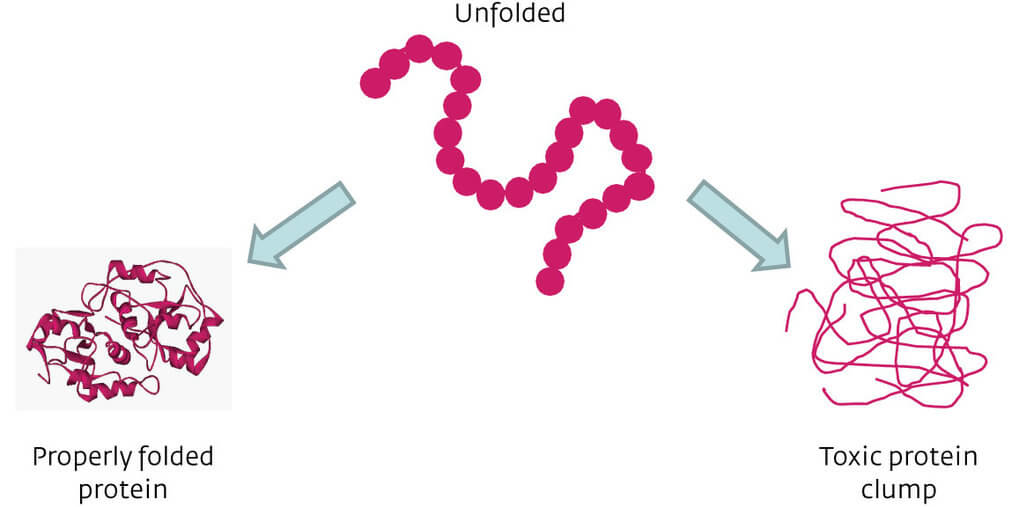
If proteins lose their shape even slightly they can become useless for their intended purpose. But heat shock proteins make sure that the proteins are folded correctly. They can fold them back into place when they become misfolded.
In cells where there is stress, but not enough heat shock proteins, the number of misshapen proteins can build up. When this happens, the misfolded proteins can aggregate together with other misfolded proteins and build up in cells. This can cause the whole cell to become dysfunctional. The outcome often leads to diseases like Alzheimer’s, where there’s a big build-up of amyloid-beta proteins, a.k.a. amyloid plaques.
The 20-year Finnish sauna study…
A study conducted by Laukkanen et al at the University of Eastern Finland followed 2315 middle-aged Finnish men. They either used a sauna once a week, 2-3 times per week, or 4 -7 times a week for 20 years (this was a huge study and I’ll come back to it several times).
The researchers found that those subjects who sauna’d 4-7 times per week were 66% less likely to suffer from Dementia. They were also 65% less likely to suffer from Alzheimer’s than those men that had just 1 sauna a week (6).
The study was also very careful to account for any other differences between the men, such as smoking, diabetes, obesity or other exercise/lifestyle factors, to focus on just the effects of sauna.
Heat shock proteins are also suggested to cause an increase in longevity as well.
For example, studies on Drosophila fruit flies and worms had interesting outcomes. Researchers found that the life span of flies increased by 15%. Also, the lifespan of worms increased by a whopping 45% compared to controls. This was found to be related to an up-regulation of a specific heat shock protein known as Hsp70 (7, 8).
Increased expression of Hsp70 has also been associated with an extended lifespan in humans. On the other hand, reduced production of Hsp70 is related to the physical and mental decline that comes with ageing.
3) Firing Up Your Longevity Genes
Sauna also stimulates the expression of genes that are associated with increased lifespan. FOXO3 and the Sirtuin family of genes are involved in many functions in the body that help us to live longer (9, 10). They include:
- increased energy production and the production and repair of new mitochondria
- repairing DNA
- reducing oxidative stress and increasing antioxidant production
- making damaged cells commit apoptosis (cellular suicide) so they don’t become cancerous
- increasing autophagy (cellular repair)
- stem cell maintenance and production
- killing senescent cells (cells which no longer function properly but continue to produce inflammatory messengers known as cytokines)
The Sirtuin genes became well-known after playing a major part in David Sinclair’s best-selling book ‘Lifespan’. The author describes his theory on the cause of ageing and how to prevent it. Heat stress specifically has been shown to up-regulate both FOXO3 and the Sirtuin family of genes. Using a sauna after workout could potentially help us live longer (9, 10).
4) Nitric oxide – The Master Molecule of Cardiovascular Health!
Nitric oxide is a wonder molecule for your arteries and veins. According to bestselling author and UK Doctor Malcolm Kendrick, it’s the “single most important factor for cardiovascular health there is” (11). It helps the blood vessels to relax, lowering blood pressure and stopping them from becoming stiff.
Arterial stiffness is a major risk factor for strokes and heart attacks. It’s also a powerful anticoagulant. It also promotes the production of endothelial progenitor cells that help to repair blood vessels.
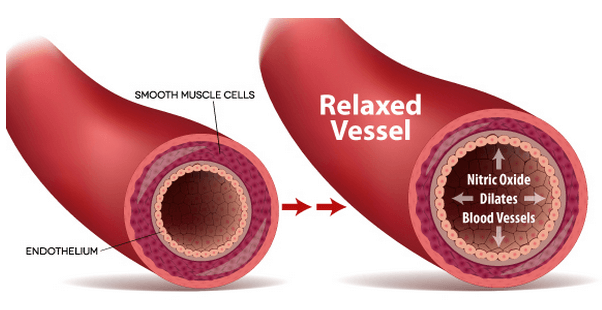
The great news is that sauna use significantly increases the production of nitric oxide (12). Studies have also shown that saunas may reduce blood pressure in subjects that are at risk for a stroke or heart attack. Saunas also reduced arterial stiffness and improved pulse wave velocity in those subjects (13, 14).
And you know what else increases nitric oxide production? Omega-3 fatty acids. Docosahexaenoic acid (DHA) is an omega-3 fatty acid that helps increase nitric oxide production. DHA causes the endothelium of the arteries to widen for increased blood flow (15).
Read here to know how much Omega-3 you need to take to protect against heart disease.
Back to the 20-year Finnish sauna study…
The Finnish study that I mentioned earlier found that the (healthy) men they studied who took between 4 and 7 saunas per week were 47% less likely to develop high blood pressure than those who had 1 sauna a week (16).
They also showed that those who had the most saunas per week were over 50% less likely to die of sudden cardiac death than those who only had one sauna a week. And those that spent over 19 minutes in the sauna on each visit were 60% less likely to die of sudden cardiac death than those that spent under 11 minutes in the sauna (17).

At the same time, those who took 4-7 saunas a week were:
- 48% less likely to succumb to fatal coronary disease
- 50% less likely to die of fatal CV disease
- reduced risk of respiratory diseases such as COPD, asthma, pneumonia
- reduced chance of death by any cause

5) Detoxification
Sauna – and specifically the sweating that it produces – helps us to get rid of environmental toxins that are abundant in our modern world.
But the concept of detox itself still seems to be quite controversial amongst health experts. Some believe that it’s nonsense or, at best, pseudoscience. However, there is much evidence to show pollution is a major health issue.
For example, our world is much more toxic than even a few years ago. Commercial chemical production rose from 1 million tons in 1930 to 400 million tons in 2001 (18). In 2011, the WHO estimated that 4.9 million deaths per year and 86 million disability-adjusted life years are attributed to environmental chemicals (19).
A Canadian report on toxic substances found in the umbilical cord blood of newborns found 137 different chemicals. These include dioxins, PFC’s, organochlorine pesticides, lead, mercury, and PCB’s (20).
In Latin America, “toxic chemicals in the environment have become an important problem and are recognized as major causes of disease and disability among children” (21). So the recognition and understanding of environmental toxins as a cause of health issues is changing. It’s just happening slowly.
The 4 Detoxification Pathways
The body has a very specific process for detoxifying chemicals. The process involves 4 phases or detoxification pathways – Phase 0, Phase I, Phase II, and Phase III. The phases take place primarily in the liver. But they also take place in the kidney, lungs, intestines, skin, and testes.
The First 3 Phases
Phase 0 involves transportation proteins that take toxins into cells.
Next, Phase 1 is a group of enzymes known as the cytochrome P450 system that oxidizes these toxins.
Phase 2 then involves conjugation (joining) of the oxidised chemicals to 1 of 6 different compounds. This may either be an amino acid, sulphur, a methyl group, glucoronic acid, an acetyl group or glutathione.
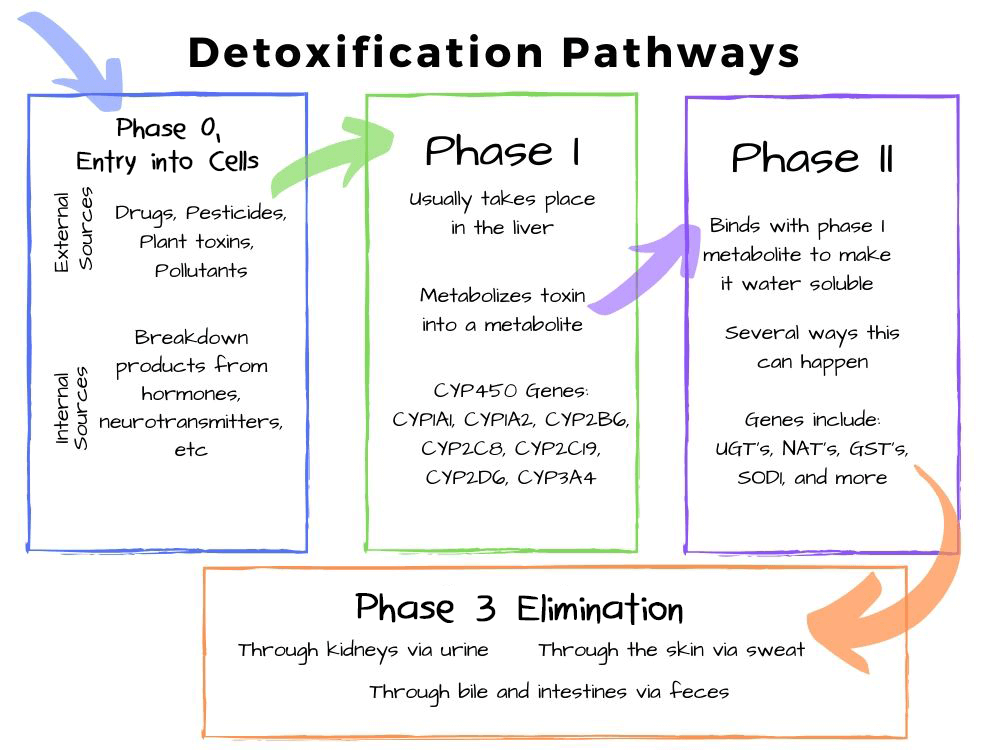
The Last Phase
In Phase 2, the conjugation process makes the toxins water-soluble. When a toxin is water-soluble, it can then be much more easily excreted from the body, either in the urine via the kidney, through the bile in feces, or in sweat (this is Phase 3).
However, one of the issues with this is that bile isn’t an efficient pathway for chemical excretion. Bile is actually reabsorbed from the gut and recirculated through the liver between 14 and 17 times. So, toxins can potentially be continually recycled throughout the body (22). This wasn’t necessarily a problem throughout our evolution. We weren’t exposed to the same level of toxins as we are now. However, now the potential toxic burden is much greater.
This is where we can utilize the sauna to significantly increase sweating to help get rid of the toxins. Although research into the sauna and reducing our toxic burden is still relatively new, we’ve had some excellent studies showing that regular sauna use can reduce levels of PCB’s, PBB’s, PBDE’s, organochlorine pesticides, and heavy metals, including arsenic, cadmium, lead, mercury and nickel (23).
So, How Often Should I Sauna?
This really depends on your lifestyle. Life is about balance, and you need to be able to make sauna a part of your routine without it causing pressure on other life commitments. Having said that, the Laukkanen et al study did show that more saunas are more beneficial. The more saunas you can fit into your schedule, the better. This includes using the sauna after a workout session, including after a travel workout!
They also found more benefits for people who were able to sauna for 19 minutes or more per session. However, again this is dependent on the individual, as sauna is a stress, so don’t do more than you can handle. You should start with a much shorter time. If you feel dizzy or have any other problems, please leave that sauna. You’ll find your tolerance level will increase with regular use, and you can slowly build up to longer sessions.
Also, please remember to rehydrate after your sauna by drinking plenty of water, as it’s really important not to get dehydrated!




